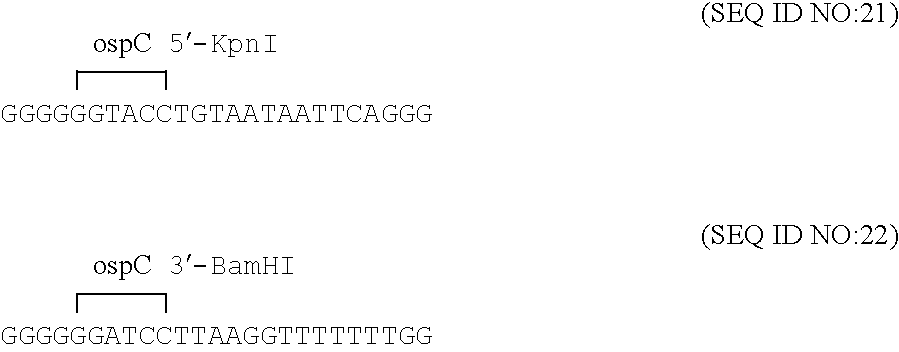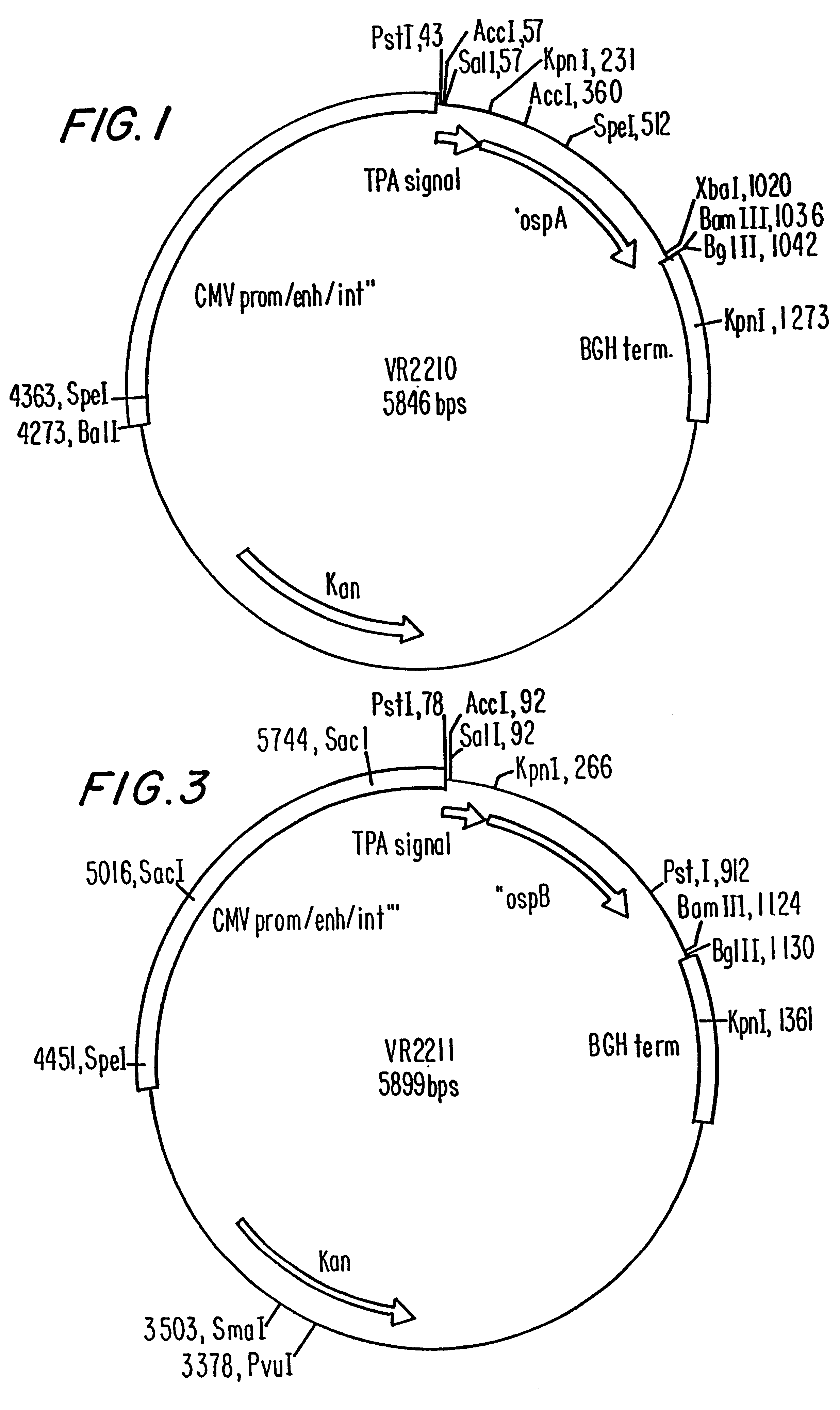Compositions and methods for administering Borrelia DNA
a technology of borrelia and dna, applied in the field of compositions and methods for administering borrelia dna, can solve problems such as cardiac, neurological and joint abnormalities, and achieve the effect of maximizing the protein siz
- Summary
- Abstract
- Description
- Claims
- Application Information
AI Technical Summary
Benefits of technology
Problems solved by technology
Method used
Image
Examples
example 1
Plasmid Construction
DNA plasmids VR2210 (FIGS. 1 and 2) (SEQ ID NO:1) and VR2211 (FIGS. 3 and 4) (SEQ ID NO:2) containing, respectively, genes coding for OspA (FIG. 5) (SEQ ID NO:3) and OspB (FIG. 6) (SEQ ID NO:4) from Borrelia burgdorferi (see FIG. 7) (SEQ ID NO:5) were constructed by isolating, individually, three DNA molecules: (1) a first DNA molecule having a DNA sequence from restriction endonuclease (PstI and XbaI) digested VR1012 plasmid (FIGS. 8, 9, 10) (SEQ ID NOS:6, 7); (2) a second DNA molecule having a DNA sequence from PCR amplified TPA 5' UTR and leader peptide coding sequence (from nkCMVintBL; see Manthorpe et al. (1993) Human Gene Therapy 4, 419-431; see also Chapman et al. (1991) Nucleic Acids Research 19, 3979-86), PstI and KpnI digested (subsequent to PCR amplification) (FIGS. 11, 12) (SEQ ID NOS:8, 9); and (3) a third DNA molecule having a DNA sequence from PCR amplified Borrelia antigen coding sequence, KpnI and XbaI digested, e.g., PCR amplified DNA encoding O...
example 2
Transfections
5.mu.g of VR2210 was transfected into both baby hamster kidney (BHK) and UM449 human melanoma cells (from Mark Cameron, Univ. Mich.) according to the protocol of Felgner et al. (1994), J. Biol. Chem. 269, 2550-2561. The resultant supernatant and cell extract were analyzed for expression of OspA by Western blot, using two anti-OspA antibodies, 3TS at 1:100 dilution and H5332 at 1:10 dilution in 5% milk / BBS (as to the antibodies, reference is made to Barbour, A. G. et al., J. Infect. Dis. 1985, 152, 478-84; Barbour et al., Infect Immun. 1983, 41, 795-804).
As the Western blot (FIG. 17) shows, UM449 cells give a higher level of expression of OspA than BHK cells. Also, there is more OspA in the culture supernatant than in the cell lysate. Therefore, the prokaryotic protein is efficiently transported out of the mammalian cells by a eukaryotic signal peptide sequence (TPA). A summary of the results shown in FIG. 17 is provided by the following tabulation.
This Example also demo...
example 3
Transfections
5 .mu.g of VR2211 was transfected into UM449 human melanoma cells according to the protocol of Felgner et al. (1994), J. Biol Chem. 269, 2550-2561. Supernatants and cell extracts were analyzed for expression of OspB by Western blot using a monoclonal anti-OspB called H68 and by a monoclonal anti-OspB H6831 (as to the antibodies, reference is made to Barbour et al., Infect. Immun. 1984, 45, 94-100) (FIGS. 18A and 18B) with the ti-OspB H68 and H6831 at 1:10 in Blotto. These antibodies detect OspB in both supernatants and cell extracts. The monoclonal anti-OspB designated H6831 binds to spirochete OspB strain B31) and to unmodified OspB (in vitro translated) but not to modified OspB (i.e., glycosylated and / or phosphorylated by mammalian cellular machinery). Possibly the epitope for H6831 is blocked by eukaryotic post-translational modifications.
A summary of the results shown in FIG. 18A is provided following tabulation.
A summary of the results shown in FIG. 18B is provided...
PUM
| Property | Measurement | Unit |
|---|---|---|
| Volume | aaaaa | aaaaa |
| Volume | aaaaa | aaaaa |
| Volume | aaaaa | aaaaa |
Abstract
Description
Claims
Application Information
 Login to View More
Login to View More - R&D
- Intellectual Property
- Life Sciences
- Materials
- Tech Scout
- Unparalleled Data Quality
- Higher Quality Content
- 60% Fewer Hallucinations
Browse by: Latest US Patents, China's latest patents, Technical Efficacy Thesaurus, Application Domain, Technology Topic, Popular Technical Reports.
© 2025 PatSnap. All rights reserved.Legal|Privacy policy|Modern Slavery Act Transparency Statement|Sitemap|About US| Contact US: help@patsnap.com



